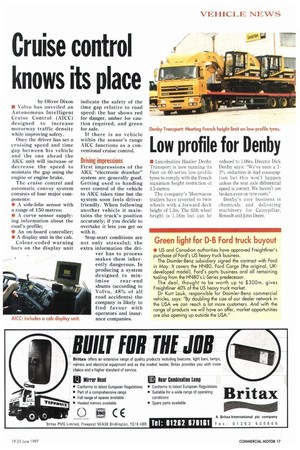Cruise control knows its place
Page 19

If you've noticed an error in this article please click here to report it so we can fix it.
by Oliver Dixon MI Volvo has unveiled an Autonomous Intelligent Cruise Control (AICC) designed to increase motorway traffic density while improving safety.
Once the driver has set a cruising speed and time gap between his vehicle and the one ahead the AICC unit will increase or decrease the speed to maintain the gap using the engine or engine brake.
The cruise control and automatic convoy system consists of four major components: • A side-lobe sensor with a range of 150 metres; • A curve sensor supplying information about the road's profile; • An on-board controller; • A display unit in the cab. Colour-coded warning bars on the display unit indicate the safety of the time gap relative to road speed: the bar shows red for danger, amber for caution required, and green for safe.
If there is no vehicle within the sensor's range AICC functions as a conventional cruise control.
Driving impressions First impressions of the AICC "electronic drawbar" system are generally good. Getting used to handing over control of the vehicle to AICC takes time but the system soon feels driverfriendly. When following another vehicle it maintains the truck's position accurately; if you decide to overtake it lets you get on with it.
Stop-start conditions are not only stressful; the extra information the driver has to process makes them inherently dangerous. In producing a system designed to min imise rear-end shunts (according to Volvo, 48% of all road accidents) the company is likely to find favour with operators and insurance Companies.






















































































































